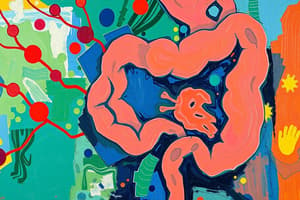Podcast
Questions and Answers
What is the primary stimulus for contraction in the gastrointestinal tract?
What is the primary stimulus for contraction in the gastrointestinal tract?
- Chemical signals
- Distension (correct)
- Temperature changes
- Hormonal release
The gastro-colonic reflex is a mechanism that stimulates motility in the lower gut when the upper gut is active.
The gastro-colonic reflex is a mechanism that stimulates motility in the lower gut when the upper gut is active.
True (A)
What reflex causes the anal sphincter to contract when feces are present in the rectum?
What reflex causes the anal sphincter to contract when feces are present in the rectum?
Rectosphinteric reflex
Distension in the small intestine inhibits contraction in the _____ due to the enteric nervous system.
Distension in the small intestine inhibits contraction in the _____ due to the enteric nervous system.
Match the type of motility to its description:
Match the type of motility to its description:
Which reflex is triggered when feces build up pressure in the rectum?
Which reflex is triggered when feces build up pressure in the rectum?
All segments of the gastrointestinal tract have only one form of motility.
All segments of the gastrointestinal tract have only one form of motility.
What effect does distension have on a sphincter located before it?
What effect does distension have on a sphincter located before it?
The gut’s activity becomes more energetically efficient because _____ in one segment inhibits motility in the preceding segment.
The gut’s activity becomes more energetically efficient because _____ in one segment inhibits motility in the preceding segment.
What happens to the motility of the stomach when there is activity in the small intestine?
What happens to the motility of the stomach when there is activity in the small intestine?
Flashcards are hidden until you start studying
Study Notes
Gastrointestinal Tract Overview
- Adult GI tract is approximately 7 meters long, functions relatively independent of body size.
- Main functions include segmental heterogeneity, motility, secretion, digestion, and absorption.
Anatomy of the GI System
- Comprises the GI tract and accessory organs like the liver and pancreas.
- Stomach is a muscular bag, varying in size from 75ml to 1L, specialized for contraction and secretion.
Four-Layered Structure of the GI Tract
- Mucosa: Absorptive surface, contains blood capillaries, metabolically active.
- Submucosa: Contains larger blood vessels, lymphatic system branches, and autonomic nervous system (ANS) components.
- Muscularis: Composed of two muscle layers for varied movements including circular and longitudinal contractions.
- Serosa: Connective tissue layer providing separation and outer coverage.
Small Intestine Features
- Approximately 6 meters long with the same four-layered structure, optimized for nutrient absorption.
- Highly vascularized with variable surface area in different segments (duodenum, jejunum, ileum).
Segmental Differences in the Small Intestine
- Duodenum: Contains Brunner's glands for mucus and bicarbonate secretion.
- Jejunum: Features long villi to maximize absorption surface area.
- Ileum: Paler, fewer vessels with Peyer's patches for immune protection, shorter villi.
Gut Barrier Function
- Tight junctions prevent unwanted substance passage between enterocytes, more pronounced in the ileum for bacterial containment.
Gut Endocrine System
- Largest hormone-secreting organ, composed of both open and closed hormone-producing cells.
- Hormones secreted by direct nutrient contact or neural stimulation.
- Hormones affect gut motility and secretory functions.
Peyer's Patches
- Part of gut-associated lymphoid tissue (GALT) located in the ileum.
- Functions include trapping microorganisms and presenting antigens to immune cells.
- Microfold cells (M cells) sample the intestinal lumen.
Large Intestine (Colon)
- Approximately 1.5 meters long with a decreasing lumen diameter.
- Comprised of the same four layers, but features longitudinal muscle arranged in three bands (taeniae coli) for motility control.
- Lacks villi, primarily involved in water absorption and mucus production for protection.
Motility in the GI Tract
- Controlled movement essential for food transport and proper mixing with digestive enzymes.
- Key motility patterns: stomach, small intestine, large intestine, and migrating motor complex (MMC) when the gut is empty.
- Governed by both neural and hormonal inputs.
Stomach Motility
- Acts as a reservoir for food, allowing for increased volume without significant pressure change.
- Primary stimulus for contractions is gastric distension after meals.
Small Intestinal Motility
- Controlled movements promote propulsion of chyme, with stronger contractions in the duodenum.
- Two main types of movement: segmentation (mixing) and peristalsis (forward movement).
Large Intestinal Motility
- Non-propulsive segmentation occurs in colon haustra, while mass peristalsis triggers coordinated contractions to move contents.
- Takes approximately 72 hours to move contents through the full colon.
Defecation Reflex
- Triggered by rectal distension, causes relaxation of the internal anal sphincter and contraction of the external anal sphincter.
Migrating Motor Complex (MMC)
- A cycle of intense contractions that rid the GI tract of undigested solids, occurring during fasting.
- Comprises phases of quiescence and irregular to intense activity.
Neural Regulation of Motility
- Enteric nervous system features two plexuses: myenteric (motility control) and submucosal (secretory control).
- Autonomic nervous system influences motility, with parasympathetic stimulation increasing secretion and motility.
Reflex Regulation of Motility
- Long and short reflexes controlled by sensory neurons and neurotransmitters for effective gut function during nutrient absorption.
- Key reflexes include the gastro-colonic reflex and the defecation reflex, affecting motility across segments.
General Principles
- All GI segments exhibit mixing and propulsive motility.
- Key contraction triggers include distension, leading to effective and efficient digestive processes.
Studying That Suits You
Use AI to generate personalized quizzes and flashcards to suit your learning preferences.




